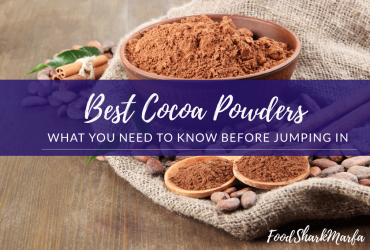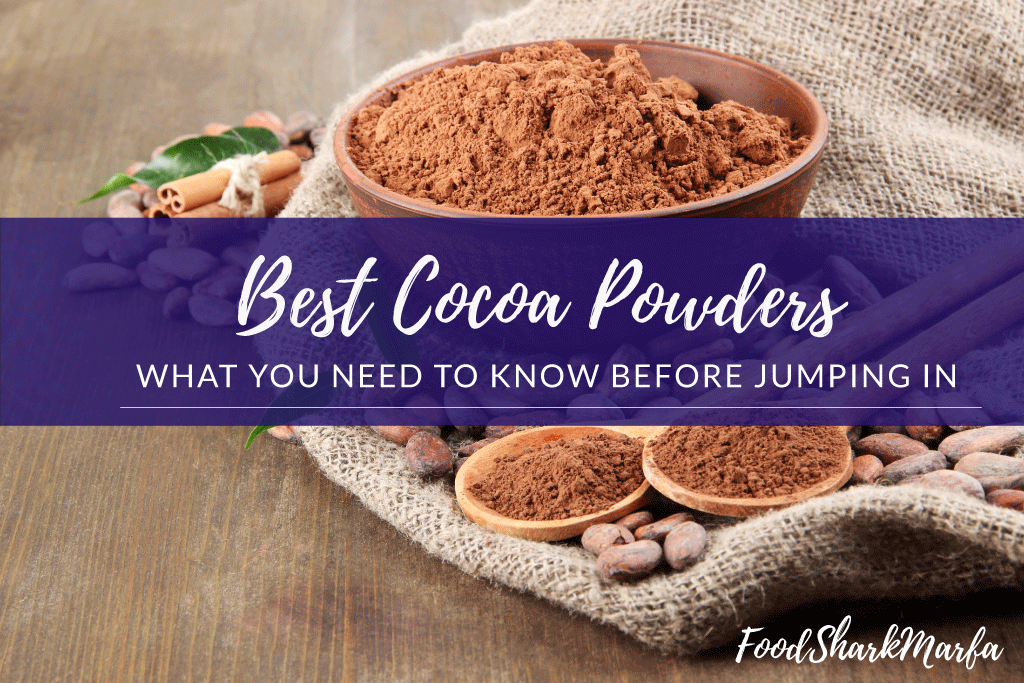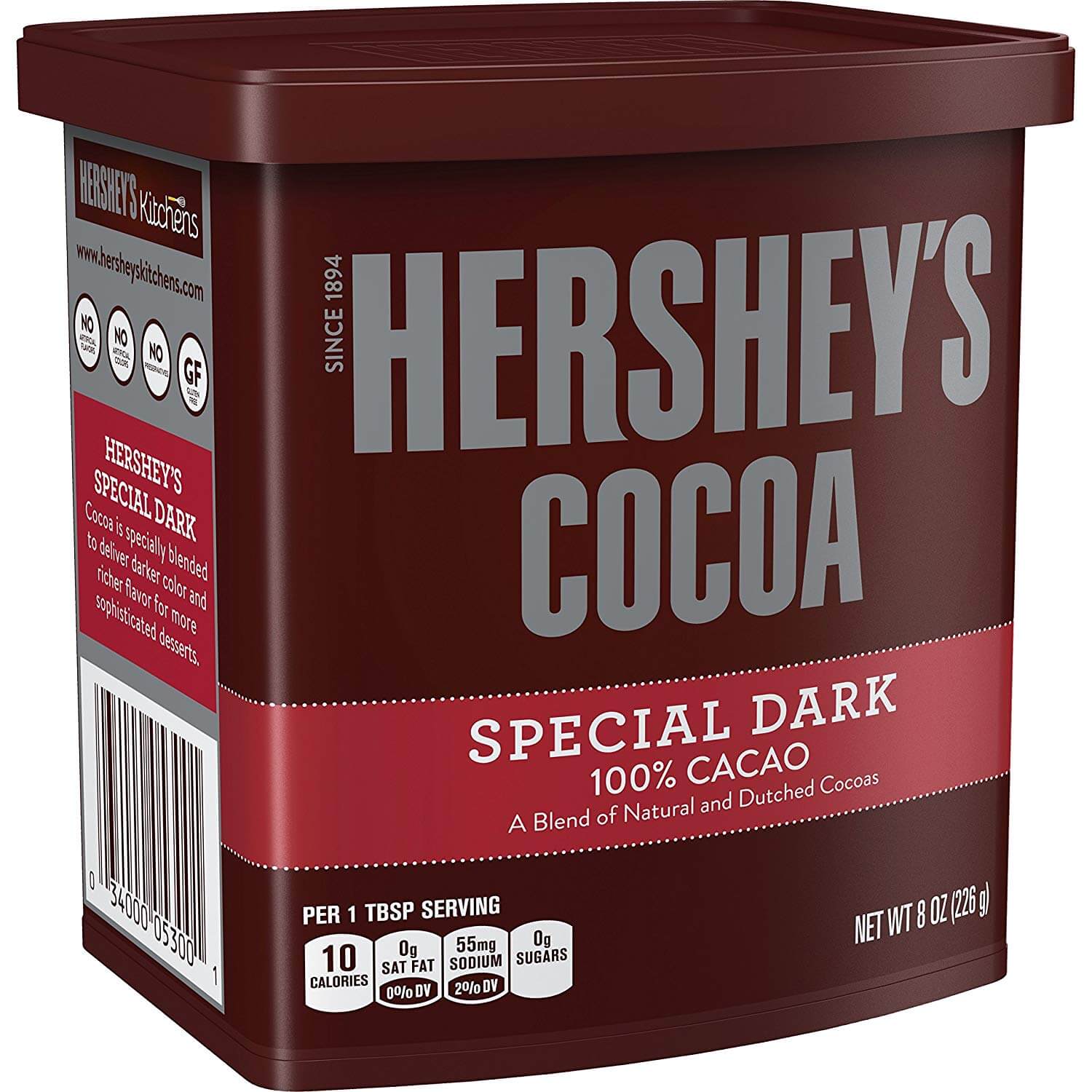Not only does cocoa powder add rich flavor and color to our desserts and cakes, it also gives us a great reason to dig out the marshmallows and make a comforting cup of hot cocoa. Cocoa has been around for centuries and even today, its health benefits are still being researched.
There are two main types of cocoa powder, natural or Dutch processed, and in this article, we take a look at the difference is between the two. Although we know there are some health benefits of cocoa, in recent years there has been growing concern over levels of heavy metals in cocoa and chocolate products, so we also take a look at the debate alongside reviews of some of the best cocoa powder available.Quick Comparison: Top 10 Best Cocoa Powder
1. HERSHEY’S Natural Unsweetened Cocoa 8 oz
The HERSHEY’S natural unsweetened cocoa 8 oz (six pack) is gluten free and OU Kosher Certified. Made of pure cacao in the US, this is ideal for making desserts with as well as being suitable for hot cocoa. The back of the can contains recipes and instructions for making frosting and hot cocoa, although if you prefer chocolate a little darker, you may need to mix in some dark cocoa with this when baking, as it is a lighter cocoa.
Unfortunately, a number of buyers do receive damaged or opened cans, which means you may have to spend some extra time cleaning up when the package arrives.
Pros
Cons
2. Anthony’s Organic Cocoa Powder
Certified USDA Organic, Anthony’s organic cocoa powder (2 lb) is suitable for those on a gluten-free diet. As this small batch tested cocoa powder has not been treated to neutralize its acidity, the final product is less refined. A small number of buyers commented that this may not have as much flavor as other organic cocoas, and that it may be drier than other pure cocoas.
Pros
Cons
3. Ghirardelli Chocolate Unsweetened Cocoa Pouch
The non-alkalized Ghirardelli 100% cocoa (8 oz) comes in a resealable pouch. This unsweetened powder is suitable for use as a hot cocoa or for in baking, although some may find it a little bitter for use as hot cocoa as it is unsweetened.
There may be less flavor to this cocoa than expected and although the pouch is resealable it may not be the easiest to reseal after use.Pros
Cons
4. Superwell Organic Cacao Powder
The USDA Certified Organic Superwell organic cacao powder (15 oz) is also GMO-free, Fairtrade, kosher and gluten free. This powder comes with a free recipe e-book and there is also a satisfaction guarantee on this cacao powder.
There may be some uncertainty as to whether this is cacao or cocoa, as the packaging does state that it has been roasted – which for some does mean that the cacao has become cocoa. This powder has also been tested for purity and heavy metals.Pros
Cons
5. Droste Cocoa Powder
The Droste cocoa powder (8.8 oz) is a pure cocoa powder that is imported directly from Holland. This is a non-GMO cocoa which is unsweetened and suitable for gluten free diets. Unfortunately, as this is packaged in a cardboard box, there is a high risk that the packaging may be damaged during shipping.
Pros
Cons
6. HERSHEY’S SPECIAL DARK Cocoa
Made from a blend of Dutch processed and natural pure cacao, the HERSHEY’S SPECIAL DARK cocoa (8 oz) is a milder and richer dark chocolate flavor. This is OU Kosher Certified and free from gluten. HERSHEY’S have however recently changed the formula for this cocoa powder and not all buyers are happy with the new flavor. There is also a risk of damage to the packaging
Pros
Cons
7. Valrhona Pure Cocoa Powder
The unsweetened Valrhona pure cocoa powder (8.8 oz) is a very fine dark mahogany-colored powder. Dutch processed; this is ideal for desserts and hot cocoa. Like other dry goods, there can be a risk of receiving this powder with shipping damage.
Pros
Cons
8. The Cocoa Trader's Dutch Processed Cocoa Powder
Suitable as a food colorant rather than a flavoring, the Cocoa Trader's Dutch Processed cocoa powder (1 lb) uses 100% cacao and has a mellow, smooth and earthy flavor. This cocoa powder is very dark – black- and is for use as a colorant in chocolate cakes. You are advised to use this black cocoa alongside a brown Dutch-processed cocoa. This cocoa powder also comes with a satisfaction guarantee.
Pros
Cons
9. E. Guittard Cocoa Rouge
The US-manufactured unsweetened E. Guittard Cocoa Rouge (8 oz) is a cocoa powder with a bittersweet flavor. This Dutch processed powder is ideal for baking. There is a risk that this may arrive with shipping damage, and as it may have a different flavor than other cocoa powders, you may prefer to use it in baking rather than as a hot cocoa.
Pros
Cons
10. Ghirardelli Majestic Premium Cocoa Powder
Ideal for premium baking, the US-made Ghirardelli Majestic Premium cocoa powder (32 oz) has a 20-22% cocoa butter content. This is a Dutch processed and unsweetened pure cocoa powder which may be more difficult to dissolve for hot cocoa.
Pros
Cons
Things to Consider Before Buying Cocoa Powder
Cacao and Cocoa
Cacao comes from the Theobroma cacao tree. The tree has large pod fruits which contain up to 60 beans within a pulp. Once the beans have been harvested, ground up and the fat removed from the ground beans, it is usually then called cocoa.
The difference between cacao and cocoa is not always clear cut though as even experts disagree as to when cacao becomes cocoa.
Some manufacturers producing unroasted or less processed cacao beans will call it cacao – possibly to draw attention to its more ‘natural’ state, while other manufactures will change its name from cacao to cocoa once it has been fermented.
Difference Between Natural and Dutch Processed Cocoa
Once cacao beans have been fermented, dried and roasted they are cracked into nibs and ground into a paste. This paste is made up of cocoa solids within an almost flavorless non-alcoholic liquor which contains around half cocoa butter fat.
The cocoa butter is extracted from the liquor to leave the solids which are then ground into a fine powder. This cocoa powder does not contain any milk, extra fats or sugars. At this point, this is a natural cocoa powder, and after this process, the powder can be sweetened or flavored, otherwise, packaged and then sold.
Natural cocoa powder can vary in color from light red-brown to dark brown and has a pH of between 5 and 6, making it acidic. It will usually be astringent with some bitterness although its flavor will depend on what cacao bean is used and also how it is manufactured.
Dutch processed or Dutched cocoa powder is washed with a potassium carbonate solution that alters or alkalizes its pH to pH 7 or neutral. Dutch process cocoa powder is usually darker colored than natural cocoa powder and its flavor tends to be smoother and more mellow.
There is a difference between the two types, so when baking you should usually use the type of cocoa powder that the recipe states, especially if the recipe includes chemical leaveners. Recipes that use Dutch process cocoa tend to be leavened with baking powder while a recipe with natural cocoa powder will usually need baking soda. If a recipe uses powder and soda, you must always use the correct cocoa as the recipe will be balancing acid and alkaline ingredients.
For desserts, sauces, puddings and ice creams, you can usually use which you prefer. Natural cocoa will usually be lighter in color whereas the Dutch processed will give more of a chocolate flavor. Some cooks will also mix the two to contrast flavor with color depth.
Hot Cocoa, Hot Chocolate and Drinking Chocolate
As well its use in baking and desserts, cocoa powder is ideal for making hot cocoa. This is made by adding either sweetened or unsweetened cocoa powder to hot milk or water. If unsweetened, then adding some sugar or sweetener to the finished drink will reduce some of the bitterness.
Traditional hot chocolate or drinking chocolate is made of small chocolate pellets that are melted before blending with milk, water or cream. This European style of hot chocolate is usually much richer than hot cocoa and may not be as popular with non-Europeans.
Most of the hot chocolate we see on our shelves is actually a hot cocoa mix, containing cocoa powder, dehydrated milk and sugar. It may also have other flavors such as vanilla or cinnamon added.
Storing Cocoa Powder
To keep cocoa powder at its best, you should put it in an airtight container in a cool place. This should allow it to keep for up to two years. Avoid keeping it in the refrigerator as the humidity can cause it to spoil faster.
Health Benefits of Cocoa
Though to be first used by the Mayans, cocoa was introduced to Europe in the sixteenth century by Spanish conquerors, and from this point it quickly became popular as a tonic for better health.
Polyphenols are antioxidants that occur naturally in cocoa, fruits, vegetables, wine and tea. Cocoa is particularly reach in these, and in specific types of polyphenols called flavanols. These flavanols are linked to benefits such as improving cholesterol levels and lowering blood pressure. Flavanols abilities to lower blood sugar levels can help improve symptoms of type 2 diabetes, although consumption of chocolate products on the whole will have a negative effect on blood sugar control.
Polyphenols are also linked with improved brain functioning, which could help reduce some risk of neurodegenerative diseases such as Parkinson’s.
Some laboratory studies have also shown that flavanols can cause cancer cell death and help prevent cancer cells from spreading; animal studies in this area have also shown some promising results. Research between cocoa consumption and decreased cancer risk in humans is still conflicting, so much more research will be needed before conclusions can be drawn.
It is worth noting that when cocoa is processed or heated, it can lose some of its antioxidant benefit, and Dutch processing of cocoa can cause a 60% decrease in flavanols.
Heavy Metal Contamination of Cocoa Powder and Chocolate
Recent research has been focusing on the concentration of heavy metals such as lead, cadmium, nickel and chromium in cocoa and chocolate.
Scientists in Indonesia found levels of all of these heavy metals in beans from South Sulawesi, Indonesia, although the levels of these metals were below the maximum critical levels recognized by the European Food Safety Authority (EFSA). A review of research into metals in food also recommended that industry standards and good agricultural practices were needed to avoid contamination of food during its processing.
Some studies have shown higher risks of some health disorders in adult cocoa/chocolate consumers, and because children are generally more exposed to cocoa products than adults, they are therefore at higher risk of ingesting metals.
It is worth noting that these heavy metals are in our environment, and we are exposed to them throughout our lives. Because they are in the ground, any crops growing in these soils will contain some contaminants, particularly lead, and the amount of this in the ground can be much higher where leaded pesticides have been used previously. Cocoa and other foods can also be exposed to lead or other metal contaminants where they are stored or processed.
The FDA has been monitoring lead in food for decades, and originally issued guidance to manufacturers, importers and distributors in which it said that the FDA would consider regulatory action if candy contained more than 0.5 parts per million of lead. In 2006, the guidance changed to recommend a maximum lead level of 0.1 ppm.
A consumer-advocacy group (As You Sow) based in California had a range of cocoa products independently analyzed and found that over half of the samples had cadmium and lead levels that were above California’s state limits – which are stricter than Federal limits. From this, the group filed a law suit against a number of chocolate manufacturers.
The law suit brought by As You Sow, related to whether labels for lead and cadmium content should be placed on chocolate bars under California’s Prop 65.
In 2018, a California Superior Court judge authorized a settlement of the case. The settlement is that within three years, a joint study to investigate and report on lead and cadmium sources in chocolate would be committed to and funded by chocolate manufacturers. The findings from this will be published and the agreement would set a threshold for determining when a Prop 65 warning will be necessary for chocolate products.
Large chocolate manufacturers, including Hershey and Nestlé are involved in this, and other smaller companies who sell chocolate in California will be able to opt into the study.
Conclusion
In this article we have looked at what point cacao becomes cocoa, and perhaps, more importantly, some of the concerns around heavy metal contamination. These concerns will be on the agenda for the near future; especially around Prop 65. It is also important that we should not forget there are some health benefits of cocoa, particularly for chronic disease such as heart disease and type 2 diabetes.
Whatever type of cocoa powder you prefer, a darker Dutch processed or a lighter natural, we hope that our reviews have helped you to choose the best cocoa powder for your chocolate cakes and your hot cocoa.













wow. That is a lot of detailed information regarding the difference between cocoa, dutch processed and cacao. I am a breast cancer survior and avoiding sugar (natural or processed) is tedious and alarming to say the least. I have changed my diet to eliminate processed sugar and look for understanding the benefits of cacao (antioxidants) and how I can incorporate it into my diet safely. Your explanation of heavy metals in different soil crops is extremely crucial for the public to understand what is happening behind the scenes to cacao, cocoa, chocolate and all the manufacturers in the world.
I continue to struggle with what types of cacao, sugar ingredient etc to use. What are your thoughts about stevia, truvia, monk fruit? I would welcome your counsel.
thank you for this commitment.
Barbara
This is great, well-researched and awesome criteria because often the cocoa can’t be seen from the container- and if you don’t enjoy it- you’re stuck with it. They also vary so drastically and I appreciate the science behind the varieties. Honestly though, the best cocoa powder I’ve had is by “no name brand”- it has a higher cocoa butter content and is a great price for its value.